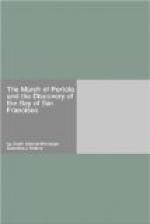[68] The Presidio anchorage.
Reconnaissance of the Port of San Francisco, with Map
-
Report of the Pilot Don Jose de Canizares to Commander Don Juan de Ayala
-
Translation of a Certified Copy of the Original in
the Archives of the
Indies at Seville.
Dear Captain: — During the four times that I made reconnaissance of this Port, and made its map, I found at the northeast and north-northeast what is shown on the map and I here describe. To the north-northeast of Angel Island, distant about a mile, there is a bay running in a direction north-northwest to south-southwest. The distance between the points forming said bay, is about two leagues, and the shore line is about two and a half leagues. To the northwest of the shore there are three small islands, forming between them and the shore a narrow passage of shallow water closed to the southwest. This bay is all surrounded with hills with few trees, which are mostly laurel and oak, but at a distance to the west-northwest, is visible a wood of what seems to be pines. In the middle of this bay is standing a high farallon with submerged rocks around it. On the northeast of it there is sufficient water for anchorage, as is shown on the map. There is no doubt of its being good anchorage for vessels, provided they have good cables and anchors, for they are subject to great stress because of the current, which at this point, cannot be less than four miles an hour[69].
North-northeast of said bay there is a mouth about two miles wide, where there are four small white rocks, the two north ones with the two south ones[70] form a channel of nine brazas depth. From this, one passes to another bay[71] more spacious, the diameter of which is about eight leagues, its shape a perfect isosceles triangle; its mouth is divided into two channels, — one, on the side of the southwest coast, turns to the northwest at about the distance of a mile and ends in two large harbors which are situated in the same shore at about four league’s distance from the mouth that communicates with the first bay; from the northwest point of the furthest harbor to the north of it, distant about one and a half leagues, in turning a point to the west-northwest, a large body of water[72] is seen, which I did not examine because the channel which leads to it is extremely limited, its depth not having three codos[73] of water; from here to the east-northeast follows a low-lying island, just above the water level, ending in a division made by the hills[74]. The other channel, which is roomy and deep, runs directly in a northeast direction till it reaches the division of the hills through a canon that runs in the same direction.




